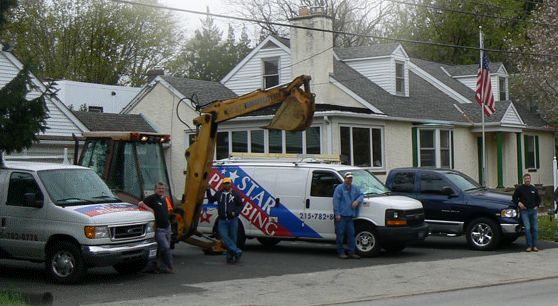What Is A Test Plug In Plumbing? – Learn About This Essential Plumbing Tool
A test plug in plumbing is a device used to seal off a pipe to allow water pressure testing on a plumbing system. It is typically made of a rubber or plastic material that is inserted into the pipe and then inflated with compressed air or water pressure. The test plug creates an airtight seal so that the pressure inside the pipe can be tested and monitored. The purpose of this test is to verify that the pipes are properly connected, sealed, and not leaking. Test plugs can also be used to temporarily patch a leaking pipe until it can be repaired or replaced.
What Is a Test Plug in Plumbing?
A test plug is an essential piece of plumbing equipment used for testing pipes and valves for leaks. It is typically made of rubber or plastic and can be used to plug openings in pipes and valves to prevent water from escaping. Test plugs are also known as test stoppers, test caps, or just plugs. They come in a variety of sizes, shapes, and materials, depending on the type of application they are meant to be used for.
Test plugs are primarily used during installation or maintenance of pipes and valves. After installation, the test plug can be fitted into the pipe or valve to check if it is functioning properly without any leaks. This testing process is necessary to ensure that the plumbing system is working correctly and safely. It can also help identify any problems with the system before they become more serious or costly to repair.
Types of Test Plugs
Test plugs come in a variety of sizes, shapes, and materials depending on the application. Common types include: inflatable test plugs, mechanical test plugs, rubber stopper test plugs, ball valve test plugs, drain test plugs, pressure relief valve (PRV) test plugs, and special purpose valves (SPVs). Inflatable test plugs are typically used for larger diameter pipes while mechanical test plugs are most commonly used for smaller diameter pipes. Rubber stopper test plugs are often used for plumbing fixtures like sinks and toilets while ball valve test plugs are best suited for tight spaces like water heaters or large pumps. Drain test plugs are designed specifically for drains while PRV and SPV tests require specialized tools due to their complexity.
Benefits of Using a Test Plug
Using a test plug helps ensure that there are no leaks in your plumbing system which can prevent costly damage from occurring over time. They can also identify potential problems before they become more serious or expensive to repair. Additionally, they provide peace of mind knowing that your pipes and valves are working correctly which helps maintain your home’s safety and efficiency standards.
How to Install a Test Plug In Plumbing
Installing a test plug requires choosing the appropriate size for your pipe or valve opening as well as marking the spot where you will install it. You will also need to inspect the area thoroughly before securing it into place with screws or adhesive tape depending on what material you choose for your plug type. Finally you should perform regular tests on your plumbing system using these tools in order to ensure that there are no leaks present before continuing with any repairs or maintenance tasks.
Best Practices For Using A Test Plug In Plumbing
When using a test plug it is important to make sure that it is compatible with the material type being tested as well as ensuring that it connects securely with both the pipe/valve opening itself as well as any other fixtures being tested prior to use. Additionally you should always make sure that all connections remain secure even after repairs have been completed so that no further damage occurs due to improper sealing of those areas where leakage could occur if not properly secured against water pressure changes within the system itself over time .
Problems That Can Arise When Using A Test Plug In Plumbing
Problems can arise when using a test plug if connections become loose due to wear over time leading to potential leakage issues within your home’s plumbing system which could cause significant damage if left unaddressed for too long . Additionally weak materials such as rubber stoppers may not be able withstand certain pressures leading them becoming worn out faster than expected thus creating further issues down the line if not replaced regularly .
Cleaning & Maintenance Of A Test Plug In Plumbing
To keep your home’s plumbing system running smoothly its important practice proper cleaning & maintenance habits when using atest plug . Avoiding corrosion by regularly cleaning off any dirt/debris buildup from both ends of the connection helps protect against potential damages which could occur over time due too build up within those areas . Additionally its important greasing connections regularly as part of routine maintenance tasks since this ensures all parts remain secure against each other thus preventing any potential leakage issues from occurring down the line . Finally replacing weakened parts/materials as soon possible prevents further damages from happening within your home’s plumbing system due too prolonged use without proper servicing .
What Is A Test Plug In Plumbing?
A test plug in plumbing is a device used to temporarily seal a pipe or fixture in order to check the pressure within the system. It is usually made of plastic, rubber, or metal, and is designed to create a watertight seal when inserted into an open pipe. Test plugs are commonly used during the installation of new plumbing systems and during repairs to identify leaks and prevent further damage. They are also useful for testing the pressure of existing systems before making any changes.
Safety Rules and Regulations for Installing a Test Plug in Plumbing
When installing a test plug in plumbing systems, it is important to adhere to local building codes as well as safety regulations. Adequate insulation should be used to prevent electrical shock from occurring when working with electricity in close proximity with the test plug. Additionally, it is important that all necessary safety equipment, such as gloves and protective eyewear, be worn while working with the test plug.
Commonly Used Materials for Installing a Test Plug in Plumbing
When installing a test plug in plumbing systems, several materials may be used depending on the type of pipe being sealed off. Plastic PTFE (Teflon) rubber gaskets are often used to create an airtight seal around pipes without causing any damage. Stainless steel clamps and thread sealants provide additional support for larger pipes or fixtures that require extra reinforcement. Copper tape or glue compounds can also be used as an alternative sealing solution for certain types of pipes.
Cost Considerations when Installing a Test Plug in Plumbing
The cost of installing a test plug can vary depending on the size and type of material being used. Purchasing bulk rates from suppliers can help reduce costs significantly if multiple plugs need to be installed at once. It is also beneficial to factor in labor costs into the total cost of purchase if professional installation services are being utilized.
Troubleshooting Tips when Issues Arise Installing a Test Plug In Plumbing
When issues arise while installing a test plug it is important to take precautions before calling repair services or attempting any repairs yourself. A visual inspection should be conducted first to determine if there are any potential problems that could cause further damage if not addressed properly. Leaks can usually be fixed quickly using simple solutions like copper tape or glue compounds designed specifically for sealing pipes without damaging them further.
FAQ & Answers
Q: What is a test plug in plumbing?
A: A test plug is a device used to temporarily seal off the end of a pipe or valve for testing purposes. It is usually made from plastic, rubber or stainless steel and has built-in threads for secure installation.
Q: What are the types of test plugs?
A: Test plugs come in different sizes and materials depending on their intended use. Plastic PTFE (Teflon) rubber gaskets, stainless steel clamps & thread sealants, and copper tape or glue compounds are commonly used materials.
Q: How do you install a test plug in plumbing?
A: Installing a test plug requires choosing the right size, marking the spot for installation, proper testing & inspection procedures, and securing the plug into place. It’s important to follow local building codes and wear safety equipment while working.
Q: What are some best practices when using a test plug in plumbing?
A: Best practices when using a test plug include working with compatible materials, connecting securely to pipes and valves, testing regularly and after repairs, avoiding corrosion with proper cleaning, greasing as part of regular maintenance and necessary replacements for weakened parts.
Q: What safety rules should be observed when installing a test plug in plumbing?
A: Safety rules that should be observed when installing a test plug include following local building codes for installation, adequate insulation to prevent electrical shock, and wearing safety equipment while working.
A test plug in plumbing is a great tool to use when testing the water pressure in a pipe or drain. It helps to ensure that the water pressure is at the correct level and can help to identify any potential problems with the plumbing system before they become more serious. It is an invaluable tool for plumbers and DIY enthusiasts alike, as it can save time, money and effort in diagnosing and fixing plumbing issues.
Author Profile

-
Star Plumbing, located in Elkins Park, PA, is a full-service plumbing company owned and operated by Mitchell Gordon. Since its inception, Star Plumbing has been providing its customers with reliable, quality plumbing services.
The Star Plumbing website offers informative articles on DIY plumbing and plumbing equipment, offering readers helpful advice and tips on how to take care of their own plumbing needs. This is a great resource for those who are looking to tackle a plumbing project themselves, as it provides useful information and advice on how to safely and successfully complete a plumbing job. Additionally, the website provides detailed descriptions of the various plumbing tools and equipment that are available, as well as detailed instructions on how to use them.
Star Plumbing’s website is a great resource for anyone with plumbing needs. Whether a customer is looking for advice on how to take care of their own plumbing or to schedule service from Star Plumbing, the website offers helpful advice and information for all their plumbing needs.
Latest entries
- April 12, 2024Plumbing Equipment And AccesoriesI Tested And Ranked The Best 10 Inch Rough In Round Toilet: And Here’s What I Found
- April 12, 2024Plumbing Equipment And AccesoriesI Tested And Ranked The Best Stone That Cleans Toilets: And Here’s What I Found
- April 12, 2024Plumbing Equipment And AccesoriesI Tested And Ranked The Best Heat Tape For Plumbing: And Here’s What I Found
- April 12, 2024Plumbing Equipment And AccesoriesI Tested And Ranked The Best Kaboom Toilet Bowl Tablets: And Here’s What I Found
